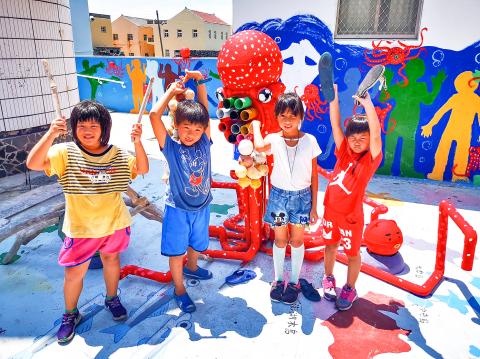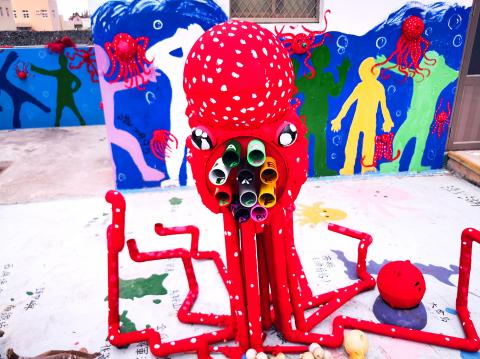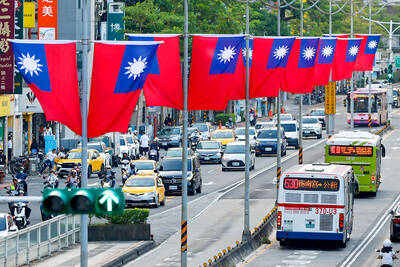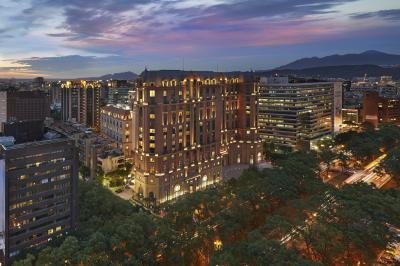Students at a school in Penghu County have taken plastic recycling to a new level with an art installation that is also a musical instrument.
While recycling plastic and other debris that washes up on beaches and turning them into art has become a trend in the county, the students at Niaoyu Elementary School in Baisha Township’s (白沙) Niaoyu Islet (鳥嶼) are the first to create a musical instrument out of trash.
The island is known for a sandbar teeming with marine life that is visible during low tide.

Photo courtesy of Bruce Wu
The school — the only elementary school on the island — organized an art project for students with the theme “technology and marine ecology,” and invited local artist Bruce Wu (吳成夫) to advise students on making art out of trash.
The students decided to base their art project on the small octopus, which is indigenous to the county and abounds in the waters near the island.
The students picked up buoys, sandals, polystyrene foam, driftwood and other trash that had washed ashore and assembled the items into the shape of an octopus with its legs outstretched in different directions.

Photo courtesy of Bruce Wu
They made it musical by giving it a “mouth” made of pipes of various lengths. Wind passes through the pipes, which each produce sound at a different pitch.
Wu said that the idea of making the installation an instrument was inspired by the way in which local residents prepare octopus for cooking — starting with pounding the meat to tenderize it.
The sound of the beating is reminiscent of a musical performance and the plastic sandals like those the students collected while cleaning beaches are often used to beat octopus meat, he said.
A string of buoys of varying size next to the installation represent an octopus’ eggs, but they also add to the “performance” when they knock about in the wind, he added.
Wu said that he hopes the installation will serve as a reminder about the need to protect marine ecology.
Octopus populations have over the past several years been dwindling due to the destruction of their habitat and overfishing, he said.

The Taipei Mass Rapid Transit (MRT) Wanda-Zhonghe Line is 81.7 percent complete, with public opening targeted for the end of 2027, New Taipei City Mayor Hou You-yi (侯友宜) said today. Surrounding roads are to be open to the public by the end of next year, Hou said during an inspection of construction progress. The 9.5km line, featuring nine underground stations and one depot, is expected to connect Chiang Kai-shek Memorial Hall Station to Chukuang Station in New Taipei City’s Jhonghe District (中和). All 18 tunnels for the line are complete, while the main structures of the stations and depot are mostly finished, he

Taipei is to implement widespread road closures around Taipei 101 on Friday to make way for large crowds during the Double Ten National Day celebration, the Taipei Department of Transportation said. A four-minute fireworks display is to be launched from the skyscraper, along with a performance by 500 drones flying in formation above the nearby Nanshan A21 site, starting at 10pm. Vehicle restrictions would occur in phases, they said. From 5pm to 9pm, inner lanes of Songshou Road between Taipei City Hall and Taipei 101 are to be closed, with only the outer lanes remaining open. Between 9pm and 9:40pm, the section is

The first global hotel Keys Selection by the Michelin Guide includes four hotels in Taiwan, Michelin announced yesterday. All four received the “Michelin One Key,” indicating guests are to experience a “very special stay” at any of the locations as the establishments are “a true gem with personality. Service always goes the extra mile, and the hotel provides much more than others in its price range.” Of the four hotels, three are located in Taipei and one in Taichung. In Taipei, the One Key accolades were awarded to the Capella Taipei, Kimpton Da An Taipei and Mandarin Oriental Taipei. Capella Taipei was described by

The Taipei Economic and Cultural Office in Vancouver, Canada, on Saturday hosted a reception to celebrate Double Ten National Day. Conservative Canadian lawmaker Marc Dalton called Taiwan a “beacon of courage and resilience in the face of rising authoritarianism,” according to a post on the Taiwan in Vancouver Facebook page. Also in attendance were fellow conservative caucus members Tako Van Popta and Chak Au, who said that Taiwan plays an “indispensable role” in ensuring global peace, prosperity and stability due to its strategic position in the Indo-Pacific region, it said. Canadian lawmaker Michael Cooper also recorded a message wishing Taiwan a